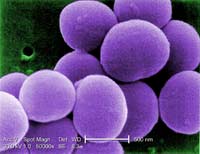Why people get MRSA over and over

Recurring MRSA or Staph is the most common problem people have with these infections. It’s also a problem that most doctors don’t know what to do about. If you’ve been struggling with recurring Staph or if your MRSA won’t go away, the following questions are probably foremost in your mind:
Why does MRSA keep recurring?
What causes MRSA reinfection?
How can I stop MRSA from coming back?
Below are the main reasons why these infections recur, what causes them to keep coming back and what you can do about it.
Over reliance on antibiotics
MRSA is becoming resistant to more antibiotics and there’s no guarantee that antibiotics will work against your infection. These drugs can also make you more prone to recurring infections later by weakening your immune system. All the negative side effects can also drain your body’s energy and slow your recovery.
Even if your antibiotics treatments work and stop your infection, these drugs only target the living bacteria that are causing your current infection. Antibiotics are unable to keep the infection from coming back again later.
Because mainstream medicine relies so heavily on antibiotics, doctors simply don’t know what to do when an infection comes back, other than prescribe more antibiotics. That’s why so many people with recurring MRSA go round and round in circles using antibiotics with no success.
One of the best things you can do about recurring infections is become more informed about antibiotic alternatives. Natural remedies often have similar results to antibiotics (or even better), but without all the downsides.
Treating the symptoms, not the cause
A good way to view the healing process is like doing some “Spring cleaning” in your house. The cleaners, brushes and mops are like treatments or remedies. By themselves, they cannot clean your house for you. But if you use the cleaning products together with a little time and elbow grease, then your house will get cleaned.
Antibiotics or remedies treat the symptoms (the infection), but not why the infection started in the first place. MRSA survives, grows and causes recurring infections if the conditions inside your body are friendly to the bacteria. A treatment may stop the infection for a while, but for many, it will come back again unless the conditions inside your body change.
Changing the environment in your body is a process and can take some time and patience. Building your immune system through diet changes, supplements and other measures is part of the answer. Addressing other health challenges that help support reinfections is another part. Addressing stealth or mutant bacteria (like biofilms and L-forms) is an important part too (more on these later).
Giving the infection less opportunity to recur is also important, especially if you have a history of frequent outbreaks. Illness, stress, not enough sleep, a cut or scrape or eating more sugar than usual can all trigger another outbreak if your immune system is already compromised.

MRSA is often too smart for any single treatment alone.
Putting too much stock in any one treatment or remedy is a common mistake that often leads to Staph or MRSA recurring over and over. It’s easy to hang all your hopes on a single product, remedy or cure, especially if a lot of people have had good results using it. But there are three main reasons why no product or treatment is enough, no matter how powerful or effective it is.
First, different people may need different remedies for the best results. Even if a product has lots of testimonials and success stories, there’s no way it can work for everyone 100% of the time. Every infection is a little bit different and there are many different kinds of infections. Even for a similar looking infection, the root cause can vary from person to person, and therefore the path to recovery can vary too.
Second, MRSA is often too smart for any single treatment alone. Imagine trying to attack a skilled enemy warrior straight on, with an obvious weapon in broad daylight. The enemy will see you coming, know what you’re trying and devise a way to counter your move. MRSA adapts, learns quickly and it can anticipate and block an obvious, frontal attack. It can take a many-sided attack and a systematized approach to overcome recurrent MRSA infections.
Third, even if your treatment does work, by itself it’s usually not enough. As mentioned above, getting to the root cause of the infection is the best way to stop recurring infections.
A big reason for recurrent MRSA and Staph is the ability of these bacteria to make biofilms. Biofilms work like an armored personnel carrier for troops, protecting the soldiers inside and hiding them from attack. In the same way, biofilms shield MRSA bacteria inside your body from attack by antibiotics or other remedies.
Unless steps are taken to address biofilms, it’s easy for another MRSA recurrence to happen. The biofilm allows the bacteria to hide out, wait for your treatments to end, and then come out and cause another outbreak.
Hospitals and healthcare facilities carry the highest risk of being exposed (or re-exposed) to MRSA bacteria. If you need to go back to the hospital, especially for a surgical procedure, it’s more important than ever to reduce the risk as much as you can.
There’s a lot you can do yourself to control the risk when visiting a hospital. The hospital’s personnel and infection control procedures play a key role as well.





